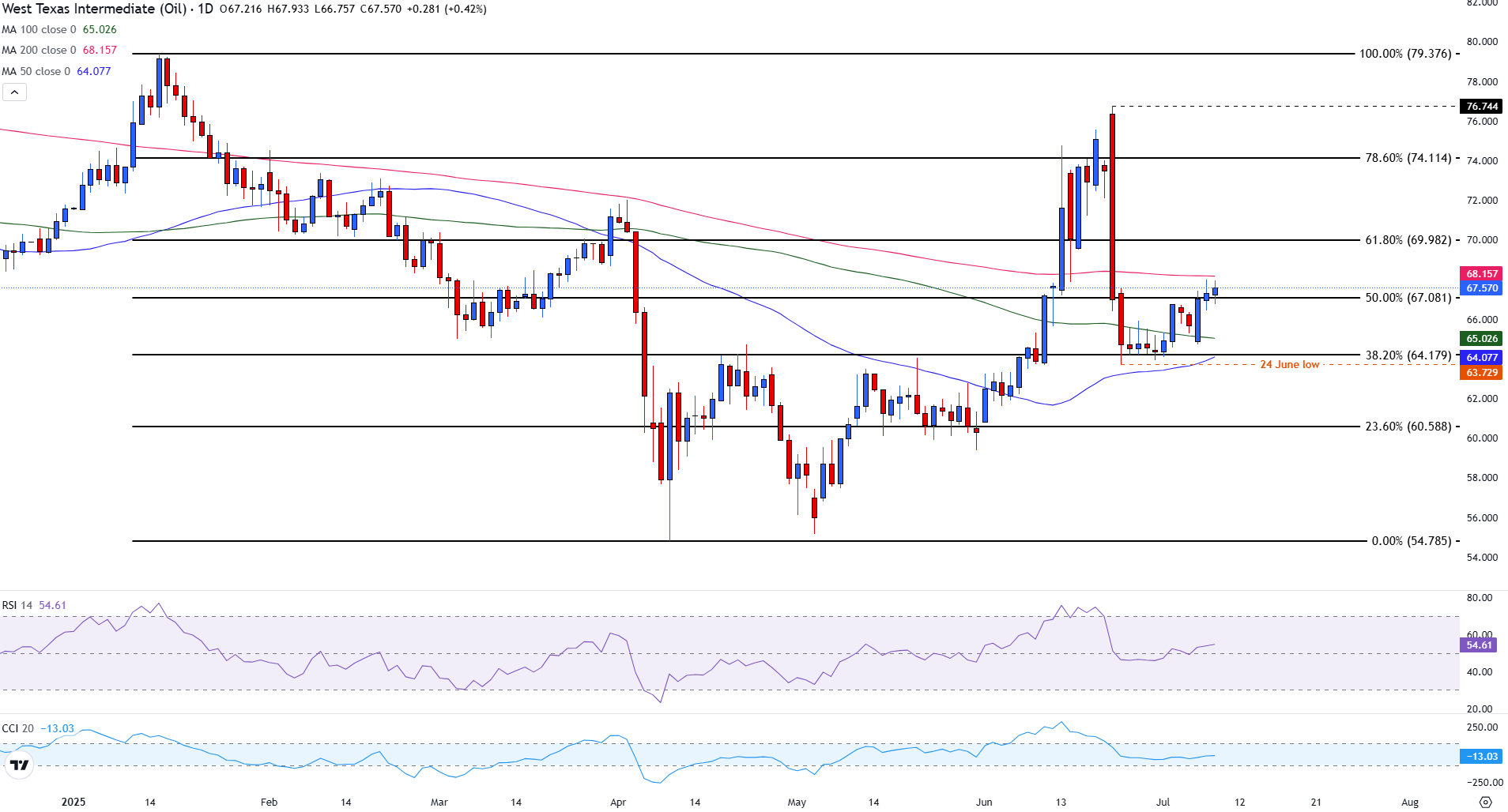- The WTI is still backed as Hutis rebel attacks in the Red Sea intensify.
- The EIA report reveals a surprise accumulation in US inventories, but geopolitical risks compensate for the increase in supply.
- WTI crude oil is still supported by the 65.00 support while the resistance remains in the 200 -day mobile average above $ 68.00.
Wi crude oil is quoting up Wednesday while attacks at the Red Sea Eclipsan the reports for the increase in supply.
The US Energy Information Administration (EIA) published its weekly inventory report, which revealed that stocks increased by 7.07 million barrels last week. The last report was expected to show a reduction of 2 million barrels.
The unexpected increase in inventories led to a slight setback in crude oil West Texas Intermediate (WTI), before recovering and quoting above $ 67.00 at the time of writing.
During the weekend, the Organization of Petroleum Exporting Countries (OPEC) and its allies (OPEP+) announced that they would increase production by 548,000 barrels per day (BPD) in August.
Between April and July, the production of OPEC+ members has already increased by 1.37 million barrels per day. However, despite the additional offer, geopolitical risks, especially in the Middle East, have limited the downward movement.
The attacks in the Red Sea and the increase in risk premiums support higher oil prices
The Hutis rebels launched a coordinated assault against the Greek flag bulk vessel Magic are Sundayforcing the crew to leave the ship before the ship sank. The attacks intensified on Monday when drones and fast boats attacked a Liberian flag ship, operated by Greeks, the Eternity C. Several crew members were killed or disappeared, and the ship sank in the early hours of Wednesday.
As a result, oil risk premiums have increased, supporting higher prices.
WTI crude oil is directed towards the 200 -day SMA, providing resistance above 68.00
The crude West Texas Intermediate (WTI) is quoting around $ 67.54, staying just above the Fibonacci recoil level of 50% of the fall from January to April at 67.08 $, which acts as an immediate support.
The price faces resistance near the simple mobile average (SMA) of 200 days at $ 68.16, with a break above this level that could pave the path for a movement towards the Fibonacci level of 61.8% in 69.98 $.
Down, the support is reinforced by the 100 -day SMA at $ 65.02 and the 50 -day SMA at $ 64.07, which aligns with the setback of 38.2% in $ 64.18, creating a strong technical floor.
WTI crude oil daily graphics

Momentum indicators are mixed. The relative force index (RSI) is slightly above the neutral level in 54, while the raw material channel index (CCI) is slightly negative, reflecting caution among the bulls. Despite the bearish pressure due to the increase in inventories and the increase in the supply of OPEC+, geopolitical risks in the Middle East are helping to keep prices supported near key technical levels.
WTI oil – frequent questions
WTI oil is a type of crude oil that is sold in international markets. WTI are the acronym of West Texas Intermediate, one of the three main types that include the Brent and Dubai’s crude. The WTI is also known as “light” and “sweet” by its relatively low gravity and sulfur content, respectively. It is considered high quality oil that is easily refined. It is obtained in the United States and is distributed through the Cushing Center, considered “the crossing of the world.” It is a reference for the oil market and the price of WTI is frequently traded in the media.
Like all assets, supply and demand are the main factors that determine the price of WTI oil. As such, global growth can be a driver of the increase in demand and vice versa in the case of weak global growth. Political instability, wars and sanctions can alter the offer and have an impact on prices. OPEC decisions, a group of large oil -producing countries, is another key price factor. The value of the US dollar influences the price of WTI crude oil, since oil is mainly traded in US dollars, so a weaker dollar can make oil more affordable and vice versa.
Weekly reports on oil inventories published by the American Petroleum Institute (API) and the Energy Information Agency (EIA) influence the price of WTI oil. Changes in inventories reflect the fluctuation of supply and demand. If the data show a decrease in inventories, it can indicate an increase in demand, which would raise the price of oil. An increase in inventories may reflect an increase in supply, which makes prices lower. The API report is published every Tuesday and that of the EIA the next day. Their results are usually similar, with a 1% difference between them 75% of the time. EIA data is considered more reliable, since it is a government agency.
The OPEC (Organization of Petroleum Exporting Countries) is a group of 13 nations oil producing that collectively decide the production quotas of member countries in biannual meetings. Their decisions usually influence WTI oil prices. When OPEC decides to reduce fees, it can restrict the supply and raise oil prices. When OPEC increases production, the opposite effect occurs. The OPEC+ is an expanded group that includes another ten non -members of the OPEC, among which Russia stands out.
Source: Fx Street
I am Joshua Winder, a senior-level journalist and editor at World Stock Market. I specialize in covering news related to the stock market and economic trends. With more than 8 years of experience in this field, I have become an expert in financial reporting.







